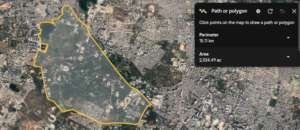The Kancha Gachibowli forest land has been at the centre of a long-standing land dispute between the Telangana government and the University of Hyderabad. Now, the government wants to auction of the forested area for IT and mixed-use development.
Published Mar 26, 2025 | 9:00 AM ⚊ Updated Apr 12, 2025 | 11:30 AM

University of Hyderabad protested the auction of 400 acres
Synopsis: Protests have erupted in Hyderabad against a Telangana government plan to auction 400 acres of forest land within the University of Hyderabad campus, sparking outrage among students, faculty, and environmentalists. Activists argue the plan threatens one of the city’s last green spaces and a vital ecosystem home to protected species, while the government insists the auction supports economic growth and excludes ecologically sensitive areas.
The Telangana government’s decision to auction 400 acres of land in Hyderabad’s Kancha Gachibowli—part of a thriving forest ecosystem within the University of Hyderabad (UoH) campus—has triggered widespread protests from students, teachers and environmental activists.
Protesters, under the banner of the “Save City Forest” campaign, warn that the move would be catastrophic for Hyderabad’s environment, endangering biodiversity and destroying one of the city’s last remaining green spaces.
The group is calling for the auction to be halted immediately.
The government insists it holds legal ownership of the land and argues that its development will support economic growth.
In June 2024, it proposed alienating the land for IT and Mixed-use projects.
It stressed that the planned auction, through the Telangana Industrial Infrastructure Corporation (TGIIC), will not harm biodiversity and excludes ecologically sensitive areas such as Buffalo and Peacock Lakes, and that the Mushroom Rock formation will be protected under an Environmental Management Plan (EMP).
Meanwhile, students have alleged that the government, through the TGIIC, was sending in bulldozers to begin clearing the proposed auction site between 10 and 12 March.
The dispute has ignited a broader debate about land ownership, urban development and environmental conservation in Hyderabad.
Besides ecological concerns, another issue remains largely unaddressed.
The land up for auction includes not only the famous Mushroom Rock but also several other important structures, notably the School of Economics building.
The School of Economics began as part of the School of Social Sciences in 1979 but became a standalone in 2012. It offers M.A., M.Phil., and Ph.D. programmes.
In 2023, the School of Economics relocated from the old social sciences building into its own dedicated building, now part of the 400-acre plot designated for auction.
This building was itself constructed on forested land. Alumnus reported that this construction was also met with opposition from the students. However, it wasn’t fruitful as the university went ahead with the construction very quickly.
Nearby are four helipads constructed by the University of Hyderabad, also within the auction boundaries
Additionally, the parcel includes water bodies like SR Lake, Malabar Kund, Bangali Fishing Pond, Frog Pond, and other significant rock formations. This has heightened concern among protesters.
However, confusion has arisen among both students and the university administration. “As per the government’s map, all these structures, including the School of Economics, fall under the parcel.
However, during our protests, the university informed us that the map was wrong. They also told us that the government conducted no survey in the area. This direct contradiction between the government and the university is not just confusing but also concerning,” Nihad Sulaiman, general secretary of the HCU Students’ Association, told South First.
Despite the TGIIC’s markings, the university administration insists nothing has been finalised yet. “We are trying to discuss everything with the government. The right authority to provide a map is the Rangareddy Revenue Department. I cannot comment on the other map,” Devesh Nigam, Registrar of the University of Hyderabad, told South First.
“I am assuring that nothing will happen to the School of Economics,” he said adding that more details clarifying the issue will be released soon.

The proposed auction area and the structures it encompasses
The Kancha Gachibowli forest land has been at the centre of a long-standing land dispute between the Telangana government and the University of Hyderabad.
Established in 1974, the UoH was allotted 2,324.05 guntas of land by the then Andhra Pradesh government in 1975.
Over the years, nearly 700 guntas were reclaimed by the government and given to other institutions, with a promise to compensate the UoH with equivalent land—an assurance that remains unfulfilled.
Despite this, the University was later directed to allot 534.28 guntas for a sports institute, again with the promise of replacement land.
The university eventually filed a petition in the Telangana High Court, asserting legal ownership of the original land.
However, in 2022, a single judge bench comprising Justice Shameem Akhtar dismissed the plea, stating that there was no Deed of Conveyance transferring the land to the University.
The court ruled that without such a deed, the government retains ownership.
It also noted that the university had previously surrendered parts of its land to the government, further weakening its legal position.
Save City Forest has not challenged the government’s ownership but argues that the decision to auction the land violates the public trust.

Approximate area of the University of Hyderabad
Using the hashtag #OxygenNotAuction, campaigners have taken to social media and staged on-ground demonstrations to raise awareness of the Kancha Gachibowli forest’s ecological value.
“This verdant expanse, often referred to as the green lungs of new Hyderabad, has been an integral part of the University of Hyderabad (UoH) campus since 1974,” protesters said in a press release.
They describe the area as a self-sustaining ecosystem that has survived decades of urban expansion. Conservationists say it is home to Schedule-1 species protected under the Wildlife (Protection) Act, 1972.
These include the Monitor Lizard, Indian Rock Python, Hispid Hare, Peafowl and the rare Four-Horned Antelope. Other species found in the forest include Hanuman Langurs, Paradise Flycatchers, Herons, Ibises, Eagle Owls and Porcupines.
Activists have issued six key demands, including the immediate withdrawal of the auction, a halt to tree felling, and a full Biodiversity Impact Assessment.
They want the forest to be declared a protected area, and cite Article 48(A) of the Indian Constitution, which mandates forest protection.
The movement has also asked the university to help conserve the land by identifying biodiversity hotspots, halting new land allotments, and ensuring existing land is used for educational or environmental purposes.
With IT Minister Sridhar Babu confirming that the government will continue with the protest, and the High Court seeking a response to a PIL on the issue by 7 April, the future of KAncha Gachibowli hangs in suspense.

The Department of Economics is nestled in the area TGIIC proposes for auction
(Edited by Dese Gowda)
